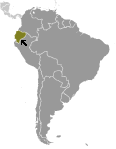World Atlas: Ecuador. On this page you can see the map, country flag and many detailed information about the people, history and economy of Ecuador.

Here you can find online selected information about the geography, inhabitants, government, economy and history of Ecuador. Included are selected statistics, an overview map and the detailed map of Ecuador. But let's start with the flag of Ecuador here:
Ecuador - Overview:
What you should know about Ecuador? Let's start with this: What is now Ecuador formed part of the northern Inca Empire until the Spanish conquest in 1533. Quito became a seat of Spanish colonial government in 1563 and part of the Viceroyalty of New Granada in 1717. The territories of the Viceroyalty - New Granada (Colombia), Venezuela, and Quito - gained their independence between 1819 and 1822 and formed a federation known as Gran Colombia. When Quito withdrew in 1830, the traditional name was changed in favor of the "Republic of the Equator." Between 1904 and 1942, Ecuador lost territories in a series of conflicts with its neighbors. A border war with Peru that flared in 1995 was resolved in 1999. Although Ecuador marked 30 years of civilian governance in 2004, the period was marred by political instability. Protests in Quito contributed to the mid-term ouster of three of Ecuador's last four democratically elected presidents. In late 2008, voters approved a new constitution, Ecuador's 20th since gaining independence. General elections were held in April 2017, and voters elected President Lenin Moreno.
Geography of Ecuador
 Where on the globe is Ecuador? The location of this country is Western South America, bordering the Pacific Ocean at the Equator, between Colombia and Peru. Total area of Ecuador is 283,561 sq km, of which 276,841 sq km is land. So this is quite a large country. How could we describe the terrain of the country? This way: coastal plain (costa), inter-Andean central highlands (sierra), and flat to rolling eastern jungle (oriente). The lowest point of Ecuador is Pacific Ocean 0 m, the highest point Chimborazo 6,267 m. And the climate is tropical along coast, becoming cooler inland at higher elevations; tropical in Amazonian jungle lowlands.
Where on the globe is Ecuador? The location of this country is Western South America, bordering the Pacific Ocean at the Equator, between Colombia and Peru. Total area of Ecuador is 283,561 sq km, of which 276,841 sq km is land. So this is quite a large country. How could we describe the terrain of the country? This way: coastal plain (costa), inter-Andean central highlands (sierra), and flat to rolling eastern jungle (oriente). The lowest point of Ecuador is Pacific Ocean 0 m, the highest point Chimborazo 6,267 m. And the climate is tropical along coast, becoming cooler inland at higher elevations; tropical in Amazonian jungle lowlands.
Inhabitants of Ecuador
Let's take a look how many people live in Ecuador. The number is: 16,290,913 (July 2017 est.). So this is not very populous country. Who lives here? mestizo (mixed Amerindian and white) 71.9%, Montubio 7.4%, Amerindian 7%, white 6.1%, Afroecuadorian 4.3%, mulatto 1.9%, black 1%, other 0.4% (2010 est.). What are the languages in Ecuador? Spanish (Castilian) 93% (official), Quechua 4.1%, other indigenous 0.7%, foreign 2.2%. And the religions: Roman Catholic 74%, Evangelical 10.4%, Jehovah's Witness 1.2%, other 6.4% (includes Mormon Buddhist, Jewish, Spiritualist, Muslim, Hindu, indigenous religions, African American religions, Pentecostal), atheist 7.9%, agnostic 0.1%. How old are the people in average? 27.7 years. We have to add that this number is the median - so one half of the people is older than this, one half is younger. And what is their life expectancy (at birth)? This: 77 years. Where the people live in Ecuador? Here: nearly half of the population is concentrated in the interior in the Andean intermontane basins and valleys, with large concentrations also found along the western coastal strip; the rainforests of the east remain sparsely populated. The major urban areas of Ecuador are: Guayaquil 2.709 million; Quito (capital) 1.726 million (2015).
Government and Economy of Ecuador
The capital of Ecuador is Quito and the government type presidential republic. Let's take a look at the administrative divisions - 24 provinces (provincias, singular - provincia); Azuay, Bolivar, Canar, Carchi, Chimborazo, Cotopaxi, El Oro, Esmeraldas, Galapagos, Guayas, Imbabura, Loja, Los Rios, Manabi, Morona-Santiago, Napo, Orellana, Pastaza, Pichincha, Santa Elena, Santo Domingo de los Tsachilas, Sucumbios, Tungurahua, Zamora-Chinchipe. Regarding the economy of Ecuador, important industrial products are petroleum, food processing, textiles, wood products, chemicals. Important agricultural products are bananas, coffee, cocoa, rice, potatoes, cassava (manioc, tapioca), plantains, sugarcane; cattle, sheep, pigs, beef, pork, dairy products; fish, shrimp; balsa wood. The most important export commodities are petroleum, bananas, cut flowers, shrimp, cacao, coffee, wood, fish and the most important export partners are US 32.3%, Chile 6.8%, Vietnam 6.6%, Peru 5.6%, Colombia 4.8%, Russia 4.6% (2016). The most important import commodities are industrial materials, fuels and lubricants, nondurable consumer goods and the most important import partners are US 23%, China 19%, Colombia 8%, Brazil 4.2% (2016). How rich is Ecuador and how rich are people in this country? The most important number here is GDP per capita (PPP): $11,200 (2017 est.). This is quite good. Let's add that this means Gross Domestic Product per person, which is recalculated with respect to the relative cost of local goods and services. And one more important number - population below poverty line: 25.6% (December 2013 est).